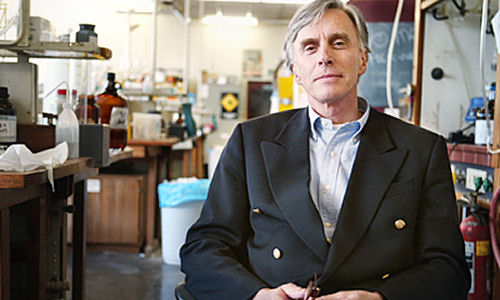Chemists from Nijmegen have developed a catalyst that binds to DNA, slides over it and splits the molecule in particular places. The researchers were able to do this by synthetically modifying a natural catalyst. This finding is a first in the field of chemistry and will help in the selective modification of polymers such as DNA. The results were published online in Nature Chemistry on 22 September.
Roeland Nolte, Emeritus Professor of Organic Chemistry at Radboud University Nijmegen, is the leader of the research project. As he explains, ‘Natural enzymes exist that are able to replicate — that is make a copy of — DNA. These enzymes consist of a ring to which another enzyme, the replicating catalyst, is clamped. We modified the natural ring and introduced porphyrines, with the result that the system is able to split DNA. We have therefore constructed our own, modifiable, biohybrid catalyst, inspired by nature.’
DNA signposting
The tiny molecular machine is actually not a ring, but a c-shape with a narrow opening. This means that it can easily bind to and slide over DNA. While it is sliding, the machine only splits at a specific sequence: the letters AAA in the DNA — a repetitive sequence of three adenine molecules. Adenine is one of the four DNA building blocks. ‘We can also influence the direction of the catalyst, by sliding it from the left or the right over the DNA’, says Nolte. ‘We do this by molecularly blocking one side of the DNA so that the catalyst can only move in the other direction.’
Visible splitting positions
The chemists have developed a new technique that shows exactly where the molecular machine has performed the splitting action. The splitting produces a functional group in the DNA that, following treatment with the streptavidin protein, can be visualised using Atomic Force Microscopy (AFM). AFM can be used to investigate the surface of a molecule in detail because the microscope scans the surface using a needle. Using this technique, the researchers were able to detect the splitting locations in the DNA and thereby determine whether or not the machine was indeed moving in the intended direction.
Molecular computer
Molecular machines like this catalyst are very useful in organic chemistry as they make it possible to split DNA in a controlled manner. Nolte explains, ‘Our ultimate goal is a fully synthetic catalyst. We would be able to use this in various solvents, whereas the catalyst we currently use only works in a water solution. The synthetic catalyst I have in mind would be a kind of molecular computer that uses the information input to perform precise tasks. We could then use this to modify polymer chains as we please, for example to strengthen them or to store information in them.’
Story Source:
The above story is based on materials provided by Radboud University Nijmegen.





